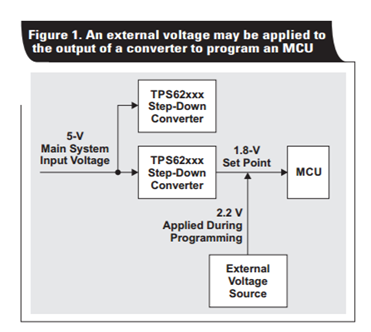SSZTAG7 january 2017 TPS62097
A somewhat common question that I receive on the TI E2E™ Community Non-Isolated DC/DC forum is, “Can I apply a voltage to the output of a DC/DC converter when that converter’s input voltage is not present?” Such a scenario typically occurs during manufacturing when programming a processor or microcontroller (MCU). In these cases, the system’s normal input voltage from the AC mains or battery is not present. So an external voltage is applied on the output just to power up the MCU in order to program it. Figure 1 shows a block diagram for a typical building automation system.
 Figure 1 Block Diagram of an MCU Being
Programmed
Figure 1 Block Diagram of an MCU Being
ProgrammedApplying a voltage to the output of a step-down converter is definitely not a typical application scenario, so this situation requires thoughtful action. The device and the application must be kept safe during this event, and their functionality may be different than expected. While the application note, Testing tips for applying external power to supply outputs without an input voltage, has all of the details and most common solutions, here are seven key system-level points to assess in designs which have a voltage applied to their output.
- All circuits connected to the input rail of the step-down (buck) converter are powered from the applied output voltage. In almost all cases, the step-down converter’s high-side MOSFET contains a body diode that provides a path from the output to the input.
- There is reverse current through the device from output to input. This current must be kept within the device’s rating so that it doesn’t overheat.
- If enabled, the device may consume current. You must account for this, if the applied voltage’s current is measured and used for pass/fail testing in production.
- If disabled, the device may consume current. Some devices, such as the TPS62097, have an output discharge circuit that sinks current from the output when the device is off.
- The voltage rating of every pin on every device that sees the applied voltage is maintained. Hot-plugging the voltage can easily cause overshoots that violate the pin’s ratings.
- Boost mode is disabled; otherwise the device may be damaged. Boost mode is enabled when any step-down converter operated in forced pulse-width modulation (PWM) mode has a voltage higher than its setpoint applied on the output and lacks a sufficient load on its input. In boost mode, the step-down converter operates bidirectionally to sink the applied output voltage. This energy moves to the input, where the voltage increases. When the voltage is high enough, the device breaks.
- The power good (PG) output is in the expected state. Depending on the level of the applied voltage, the enable (EN) pin status and the specific device, PG may not be in the correct state to operate something else in the system.
Each of these points has simple solutions for most systems. The key thing to remember when designing your system is to check if an output voltage is applied without an input voltage and plan for it during design. This allows easy and reliable system operation.
Additional resources:
- Read the blog: What is that giant tantalum cap on the input of the EVM?